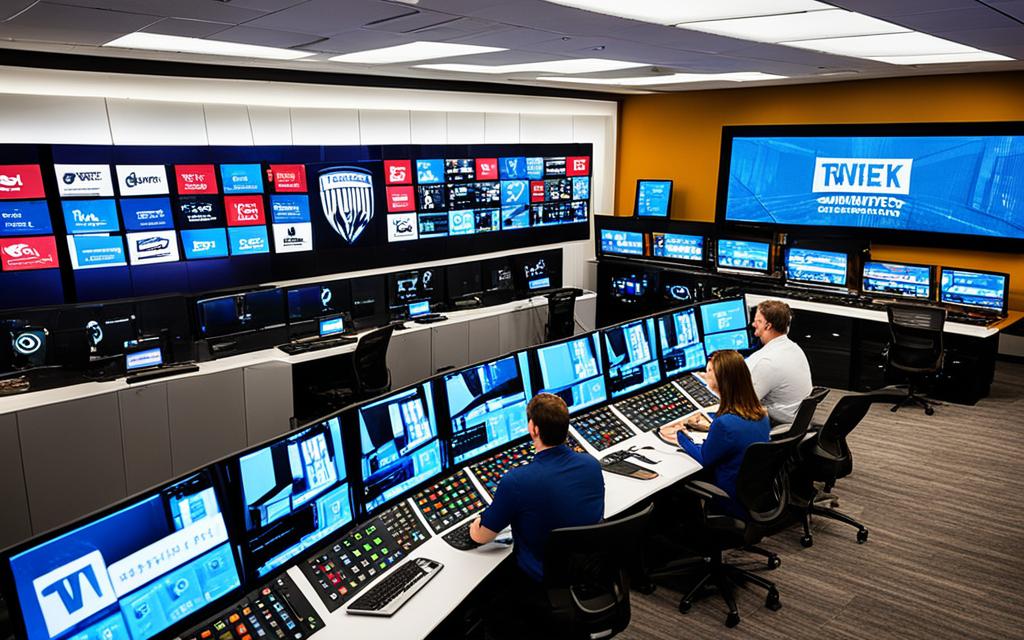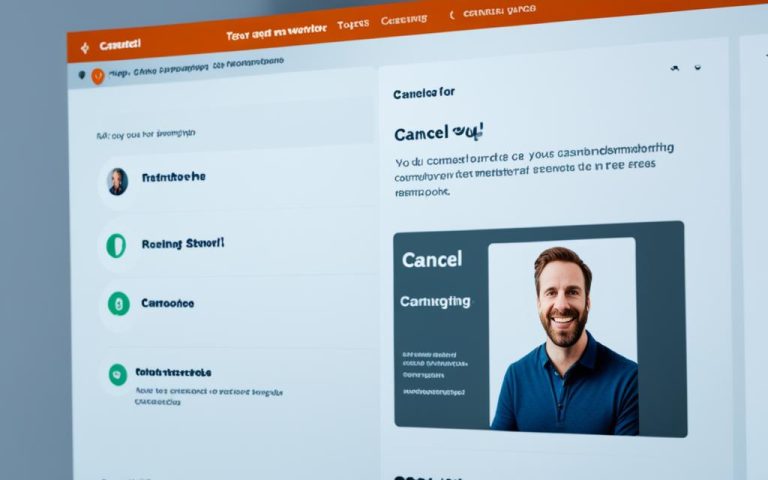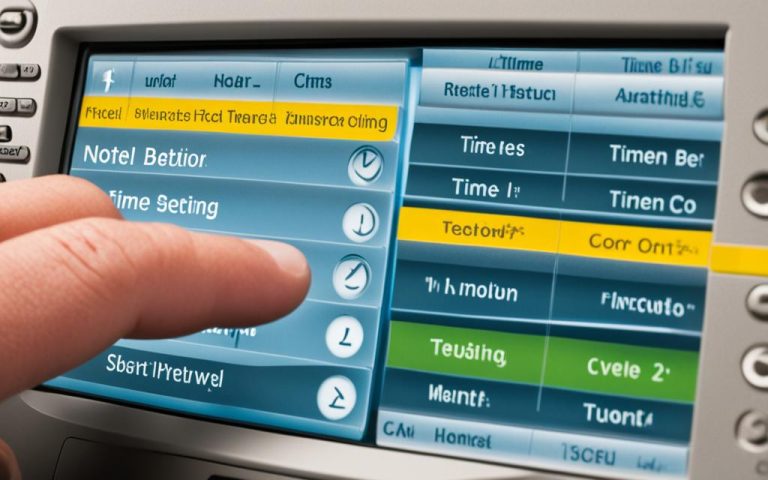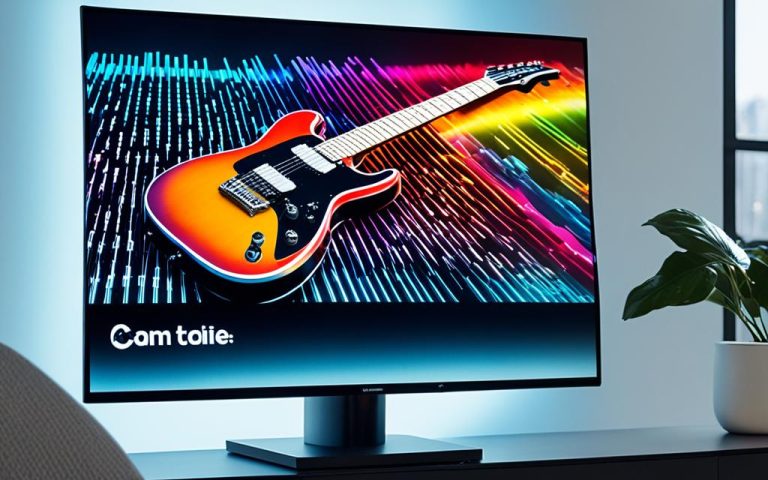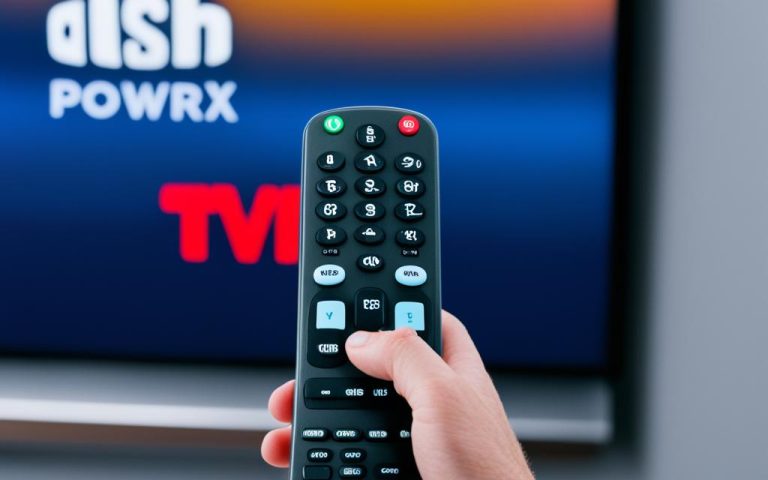Starting a TV network needs careful planning and thought. You must set up your home network and decide on wired or wireless connections. This article will cover the key steps and things to think about when starting a TV network1.
Key Takeaways:
- Ensure you have a reliable home network setup to support your TV network operations.
- Choose between wired and wireless connections based on your network requirements.
- Consider the costs and payments associated with cable, direct broadcast satellite, IPTV, and virtual MVPD services.
- Comply with legal requirements, such as obtaining a broadcasting license and adhering to FCC regulations.
- Focus on creating a strong brand identity for your TV network.
- Understand copyright laws and licensing agreements for content distribution2.
Starting a TV network is exciting but requires careful planning. Make sure your home network is stable and reliable. Your TV network’s success depends on your home network and internet connection’s performance3.
You can choose between wired and wireless connections for your home network. Wired connections are reliable and good for broadcasting. Wireless connections are flexible and easy to use with many devices. Pick what’s best for your needs2.
Think about the costs of cable, DBS, IPTV, and virtual MVPD services. These services often have monthly fees based on your channel choices. Knowing the costs helps with budgeting for your TV network1.
Getting a broadcasting license and following FCC rules is crucial. These rules ensure your network meets industry standards and public expectations. Not following FCC guidelines can lead to big penalties or losing your broadcasting rights1.
Creating a strong brand identity is key to standing out in TV. This means designing a great logo, a unique look, and a clear voice. A strong brand attracts viewers and advertisers for long-term success2.
Understanding copyright laws and licensing is vital for your TV network. Copyright laws protect creators’ rights, and the right licenses let you legally broadcast content. Ignoring these laws can lead to legal trouble and harm your network’s reputation2.
Starting a TV network is complex but rewarding with the right planning. Follow the steps and think about the factors mentioned here to lay a strong foundation. Innovate, keep up with trends, and offer great content to engage your viewers.
Key Takeaways:
- Ensure you have a reliable home network setup to support your TV network operations.
- Choose between wired and wireless connections based on your network requirements.
- Consider the costs and payments associated with cable, direct broadcast satellite, IPTV, and virtual MVPD services.
- Comply with legal requirements, such as obtaining a broadcasting license and adhering to FCC regulations.
- Focus on creating a strong brand identity for your TV network.
- Understand copyright laws and licensing agreements for content distribution2.
Home Network Setup: What You Need to Know
Before starting your TV network, it’s key to know about home network setup. A well-set home network is crucial for a smooth TV network experience. We’ll cover the basics of setting up your home network, including wired vs. wireless options and how to extend your network’s reach.
Wired vs. Wireless Home Network
Setting up a home network can be done with wired or wireless connections. Wired networks use Ethernet cables, while wireless networks rely on Wi-Fi.
Wired networks are faster and more reliable, offering speeds from 1000 Mbps to 1 Gbps with Cat5e cables. Wireless networks, however, are cheaper and easier to set up. They let you connect devices without cables, making it convenient and flexible.
Wireless networks can slow down with more devices connected, unlike wired networks which keep speeds steady. Wireless networks also face more cyber threats than wired ones. So, it’s vital to use strong security measures for your network.
Extending Home Network Range
Having a strong and wide home network is key for a great TV network. Here are ways to make your network reach further:
- Ethernet cables: Ethernet cables can stretch your network up to nearly 100 meters, connecting devices across different spots4.
- Wireless mesh systems: Mesh systems are easy to set up and grow your network. They use router-like nodes to create a strong network4.
- Virtual local networks (VLANs): VLANs segment your network, boosting speeds and security. They keep devices in separate groups, improving network performance and security4.
Keeping your network safe is also crucial. Use strong passwords, change default ones, turn on firewalls, and limit router remote access unless needed5. Also, keep an eye on network performance to ensure a smooth TV experience. Check bandwidth, latency, and jitter, improve Wi-Fi, and pick the best channels to reduce interference5.
With a well-planned and set home network, you’re ready to start your TV network. Next, we’ll guide you through setting up your network step by step.
Setting Up a Home Network
Setting up a home network is key to a strong and efficient TV network setup. You can choose from wired, wireless, or both. It’s important to know the main steps and considerations.
Choosing the Right Router
First, pick the right router. It connects all your devices and lets them talk to each other and the internet. Think about your network size and how much data you’ll use. For streaming HD movies and online games, a Wi-Fi 6 router is best6.
Wired or Wireless?
Decide if you want a wired or wireless connection. Wired is great for heavy use like gaming or streaming HD movies6. It’s faster and more reliable than wireless. Wireless is good for easy setup and moving devices around without cables6. Mixing both wired and wireless can give you the best of both worlds6.
Extending the Wi-Fi Signal Range
If your Wi-Fi signal doesn’t reach everywhere, you might need to boost it. Use network extenders to spread the signal far and wide6. This way, you get a strong connection everywhere in your home.
Enhancing Security
Security is a big deal for your home network. Keep it safe from hackers and threats. Use WPA2 or WPA3 encryption for better security6. Also, change the default admin details and update your router’s firmware often.
Accessing the Router’s Admin Page
To manage your router, go to its admin page. You can find it at 192.168.0.1, 192.168.1.1, or 192.168.2.16. There, you can set up your network, control access, and keep everything running smoothly.
| Routers | Features |
|---|---|
| D-Link DIR-657 Wireless N HD Media Router | Recommended for setting up a home network7 |
Recommended Devices for Media Storage and Playback
For your TV network, some devices make media storage and playback better. A NAS like D-Link’s ShareCenterTM 2-Bay NAS is great for storing and protecting your files7. The Boxee Box by D-Link is another good choice. It connects to your TV for easy access to network and internet content7.
Follow these steps and consider the data to set up a reliable, secure, and great TV network. Use wired and wireless connections, boost your Wi-Fi signal, and enjoy smooth streaming. With the right router and devices, you’re ready to manage your TV network well.
Wired vs. Wireless Home Network Setup
Setting up your home network for your TV has two main choices: a wired network connection or a wireless network connection. Each has its pros and cons. It’s key to know the pros and cons of wired vs. wireless to pick the best for your needs.
A wired network connection uses Ethernet cables to link devices to your router or modem. This method gives you a reliable and fast internet connection every time you plug in8. Ethernet cables, like Cat 5e and Cat 6, offer speeds from 1 Gigabit to 10 Gigabit9. They can stretch up to 300ft or more with active cables9. Wired connections are great for things needing steady speeds and low delay, like online gaming and streaming to media centers10.
On the flip side, a wireless network connection lets devices connect to the internet without cables. It’s more common and handy, especially for homes with many devices8. This type lets you connect many devices at once, giving you freedom to move around without being tied down by cables8. Yet, wireless connections might get interrupted by thick walls or being far from the router8. To boost coverage, consider network extenders or mesh routers, which use several access points for better signal8.
Both wired and wireless setups give you fast and strong internet for activities like gaming, streaming, and sharing files8. Your choice depends on what you need and like. Wired is known for its dependability and steady speeds, while wireless is more convenient and flexible8. Think about your home size, device count, and network activities when deciding.
Pros and Cons of Wired vs. Wireless Home Network Setup
| Wired Connection | Wireless Connection |
|---|---|
| Reliable and fast | Convenient and flexible |
| Secure | Potential for disruptions |
| Consistent speeds regardless of distance from the router | Dependent on various factors like router generation and distance |
| Not affected by obstacles | Potential for decreased signal strength due to obstacles |
| Wired connections support fewer simultaneous connections without additional equipment | Wireless connections support mass connectivity with multiple devices |
Both options have their ups and downs, so weigh your needs carefully. Your choice will affect your home network’s performance for your TV.
For more on setting up a home network, check out Cable Matters, ScreenBeam, and HighSpeedInternet.com for tips and advice.
Extending Home Network Range
If your home is big or has a tricky layout, you might need to boost your network’s reach. You can do this with Ethernet cables, wireless repeaters, or mesh systems.
Most routers work on 2.4 GHz and 5 GHz frequencies11. The 2.4 GHz band covers more area but can get crowded. Switching to 5 GHz can make your Wi-Fi faster11.
Updating your router’s firmware can make it work better and keep it safe11. Newer routers support Wi-Fi 6, Wi-Fi 6E, or Wi-Fi 7 for faster speeds11.
Wireless repeaters can boost your router’s signal to cover more space11. Mesh systems spread out internet access all over your home11. Mesh systems are more expensive but give the best coverage11.
Ethernet cables offer a stable connection for devices. Wi-Fi access points also work well for better performance than wireless extenders11.
Powerline adapters use your home’s electrical system for internet access. They help cover areas hard to reach with Wi-Fi11.
| Device | Coverage | Approximate Price |
|---|---|---|
| Netgear Orbi Outdoor extender | Over 200 feet | N/A |
| Asus RT-AX86U Wi-Fi router | N/A | N/A |
| Eero 6 Plus mesh system | Up to 4,500 square feet | $300 |
| TP-Link Deco W7200 Mesh Router | Up to 5,500 square feet | $190 |
For mesh systems, place satellites 10 to 15 meters apart12. They connect back to the router, not the nearest satellite, which affects coverage12.
Fix slow Wi-Fi by checking wired connections and updating your router13. Place your router in an open area to improve coverage13. Using the 5GHz band and changing channels can also boost your Wi-Fi13. Watch for Wi-Fi intruders and use QoS tools for better network performance13.
Knowing how to extend your network can make sure you have good coverage everywhere. This helps solve any connectivity problems you might have.
Home Network Security Tips
Keeping your home network safe is key when you start a TV network. Use VLANs and VPNs for routers to protect your network and data from threats.
Segment your network with VLANs
Using VLANs to segment your network helps reduce congestion and boosts security. VLANs make separate virtual networks within your physical one. This lets you control access and keep different devices apart. It stops unauthorized users or infected devices from messing with your TV network.
VLANs also help manage network traffic and make things run smoother.
Encrypt traffic with a VPN for routers
A VPN adds an extra security layer by encrypting your data. It makes a secure connection between your device and the internet, keeping your data safe. Using a VPN for routers protects all devices on your network, including your TV setup. VPNs encrypt data, so hackers can’t intercept or access it without permission.
When setting up your network, remember to:
- Use strong, unique passwords for all accounts and devices14
- Think about using security software with multiple defenses14
- Reboot devices often to lower the risk of malware14
- Keep routing devices updated to reduce risks14
- Set up wireless networks with strong passwords1415
- Limit who can access your network’s inner workings14
- Use wireless network segments for better security14
- Think about using your own routing devices for better control14
Follow these tips and use VLANs and VPNs for routers to keep your TV network and data safe. Stay ahead by regularly updating your network’s security to fight new threats.
| Statistic | Data |
|---|---|
| SSIDs can be up to 32 characters in length | 32 characters |
| A strong router password should be at least 12 characters long | 12 characters |
| It is recommended to change the router password every six months | 6 months |
| Four types of Wi-Fi protection systems commonly used are: | Wired Equivalent Privacy (WEP), Wi-Fi Protected Access (WPA), Wi-Fi Protected Access 2 (WPA 2), and Wi-Fi Protected Access 3 (WPA 3) |
| WPA 2 and WPA 3 are considered the better options for securing Wi-Fi | 2 options |
| Strong passwords should contain a mix of upper- and lower-case letters, numbers, and symbols | Number varieties |
| Examples of IoT devices include wearable fitness trackers, smart refrigerators, smartwatches, and voice assistants like Amazon Echo and Google Home | Devices |
Evaluating Home Network Hardware
Before you start setting up a TV network, check your home network hardware. Look at the modem, router, switch, and access point. Knowing what each does helps build a strong and efficient network for your TV.
Access Device (Modem)
The modem connects your home to the internet. It takes the internet signal from your ISP and changes it for your devices. When picking a modem, think about internet speed, ISP compatibility, and the latest tech. For example, Wi-Fi 6 is the newest Wi-Fi standard16.
Router
A router directs traffic and connects devices to the internet. Choose based on how many devices you have and their needs. For many devices on 5 GHz Wi-Fi, a tri-band router is best16. Update your router every year or two to stay with the latest tech16.
Switch
A switch adds more Ethernet ports to your network. It lets you connect devices like smart TVs and consoles directly for better performance. When picking a switch, think about how many ports you need and if you want a managed switch with extra features5.
Access Point
An access point (AP) spreads your network’s Wi-Fi signal. It lets devices connect wirelessly. Look at the AP’s range and if it works with your network. You can also boost coverage with more APs and Ethernet cables5.
Checking your home network hardware is key to a good TV network setup. Know what each part does – modem, router, switch, and AP. Think about the latest tech, device compatibility, and network performance like bandwidth and latency165.
| Home Network Hardware Components | Considerations |
|---|---|
| Access Device (Modem) | – Internet speed support – Compatibility with ISP – Latest technology standards16 |
| Router | – Number of devices and connections – Regular upgrades16 |
| Switch | – Number of required ports – Managed switch with advanced features5 |
| Access Point | – Range and coverage – Compatibility with existing infrastructure – Methods for expanding network range5 |
Branding Your TV Network
To make a TV network successful, you need a strong brand identity that speaks to your audience. The name of your station and the shows you offer are key to defining your brand and drawing in viewers.
When picking a name for your station, think about what your network stands for. A catchy and unique name helps you stand out and makes it easier for people to remember you. Using keywords related to your shows and audience can also boost your network’s online visibility.
Having a clear plan for your programming is also vital. Decide on the type of shows you’ll have and make sure they match what your audience likes. Use market research to find out what people want and use that to shape your content. This way, you can draw in viewers and build a dedicated fan base.
Looking at industry stats can give you useful insights for branding. For instance, over 500 content brands have started TV channels with Amagi in 40+ countries since 200817. Big names like CuriosityStream and Discovery Networks have joined in. This shows the potential for success and the need to brand your network well to stand out.
Also, think about how viewers are changing their viewing habits. Even though streaming is big, linear TV is growing on free ad-supported platforms like Roku and Hulu17. So, planning your content and branding for both streaming and traditional TV can help you reach more people.
Understanding the ad world is key to making money and partnering with brands. Stats show advertisers spent over $14 billion on connected TV in 2021, a 60% jump from the year before17. This info can help you attract advertisers and make money through ads and sponsorships.
Keep an eye on the cable TV market, which is dropping fast17. Advertisers are moving online. Staying current with these trends lets you adjust your branding and shows to stay relevant.
It’s not just about your name and shows. The overall viewing experience shapes your brand too. Investing in quality gear like cameras and lighting can make your content look better and improve how viewers see your brand18.
Also, nice graphics and a well-designed studio can boost viewer engagement and strengthen your brand18.
Branding Strategies for Your TV Network
| Branding Strategy | Description |
|---|---|
| Solidify your station name | Choose a name that aligns with your content and target audience, enhancing recognition and search engine visibility. |
| Develop a captivating logo and visual identity | Create a visually appealing and memorable logo that reflects your brand’s personality and values. |
| Define your programming strategy | Research the market and audience preferences to offer unique and compelling content. |
| Utilize social media and online platforms | Engage with your audience through various online channels to build brand awareness and loyalty. |
| Collaborate with advertisers and brand partners | Forge partnerships to generate income and establish brand credibility. |
By using these branding tips and industry stats, you can make your TV network stand out. This will help you attract viewers and build a loyal audience for success.
Copyright Laws and Licensing
Starting a TV network means understanding copyright laws and licensing for music. You need to get music licenses and think about using royalty-free music to save money.
PPR (Public Performance Rights) licenses are needed for showing films, videos, and TV in public. These licenses can cost from $100 to $1,000, based on the work and its owner19. The price of a PPR license changes and depends on the copyright owner19.
Student groups and clubs need PPR licenses to show movies for fun19. The cost of a PPR license changes with the movie or TV show19.
For training programs for professionals, using films under fair use can be tricky. You might need to talk to experts19. The fair use rule lets you use clips for teaching, but you must think about the work, how much you use, and its effect on the market19.
For most showings outside class, you need a “non-theatrical” public performance license20. This license can cost a few hundred dollars. You can get it from distributors like Swank Motion Pictures, Inc., or the copyright holder, usually the studio20.
C-SPAN lets you use their videos online for free for some government events21. Videos of debates from the U.S. House and Senate are free for everyone21. But, you need a license for special events like Speaker elections and State of the Union addresses21.
For documentaries, TV shows, or other uses that make money, you must get a license from C-SPAN21. This includes congressional hearings, press conferences, and public appearances21. Using C-SPAN videos without a license is not allowed21.
To follow the law and avoid trouble, it’s key to know about copyright laws and music and video licenses. Getting the right licenses and using royalty-free music can protect your TV network. It also makes sure your broadcasts are legal and go smoothly.
Overview of Copyright Laws and Licensing
| Copyright Laws | PPR Licenses |
|---|---|
| – PPR licenses are required for films, videos, and TV programs. | – Cost of PPR licenses varies depending on the work and copyright owner19. |
| – Fair use doctrine allows for teaching purposes under certain conditions19. | – Obtaining a “non-theatrical” public performance license is necessary for most showings outside of the class context20. |
| – Use of copyrighted material in face-to-face teaching falls under fair use exception at nonprofit educational institutions19. | – Licenses can be acquired from authorized distributors or copyright holders20. |
| – Licensing is required for documentaries, films, television programs, and other video uses21. |
By understanding copyright laws and licensing, you can use music and videos legally and ethically in your TV network. This ensures a legal and enjoyable viewing experience for your audience.
Conclusion
Starting a TV network takes a lot of planning and thought. We’ve looked at the steps and things to think about for your own TV network in this article.
The TV industry has changed a lot over time. It went from just a few options to DVR technology and streaming services. But, many new TV networks struggled, and the competition is still tough22. Now, more people are cutting the cord, but it’s only recently we’ve seen clear proof of demand22.
When you start a TV network, knowing the IPTV business well is key23. You need to work hard, do your homework, and understand the market well23. Offering a variety of content and promoting it well can make watching TV better for viewers2324.
The TV industry keeps changing, and platforms like Roku offer great chances for channel owners24. Roku is the biggest connected-TV platform, with 40 million users24. This means more money from ads for channel owners as more people use Roku24.
To get your TV network noticed, try guerrilla marketing and make a strong YouTube channel24. Being on different CTV platforms and letting users switch accounts makes watching easier24. Making sure your images look good, load fast, and work well on all screens is key for a great viewing experience24.
By following these tips and keeping up with TV changes, you can make a successful TV network that grabs viewers’ attention222324. Remember, it’s important to adapt to new tech, meet what viewers want, and promote well2324. So, begin your TV network journey now and explore the changing TV world.
FAQ
What are the key steps involved in starting a TV network?
Starting a TV network means understanding home network setup and evaluating your hardware. You also need to brand your network and follow legal rules on copyright and licensing.
What do I need to know about home network setup?
Knowing how home networks work is key. You should understand the difference between wired and wireless connections. Also, learn how to make your network reach farther. This will help you create a smooth TV network experience.
Should I choose a wired or wireless connection for my TV network?
The choice between wired and wireless depends on what you need. Wired gives you faster speeds and better security. Wireless offers flexibility and ease. Think about what’s best for your TV network.
How can I extend the range of my home network?
To extend your network, use Ethernet cables, wireless repeaters, or mesh systems. These methods help boost your Wi-Fi signal. Knowing how to do this is key for good coverage in your TV network.
What are some home network security tips for starting a TV network?
Keep your network safe by using VLANs to organize your network and a VPN to encrypt your data. These steps will protect your TV network from threats and unauthorized access.
How do I evaluate my home network hardware for starting a TV network?
Check your network hardware like the modem, router, switch, and access point. Knowing what each does helps you build a strong network for your TV network.
How can I effectively brand my TV network?
Pick a station name that fits your content and audience. Define your programming strategy. A strong brand will draw viewers and build loyalty.
What should I know about copyright laws and licensing for my TV network?
Learn about copyright laws and licensing for broadcasting music. Get the right licenses and consider royalty-free music to save money. Following the rules keeps your TV network legal.
How can I start a TV network successfully?
Plan well and know about home networks, wired vs. wireless, and security. Follow the steps in this article to start and grow a TV network that meets your goals and wins viewers.
Source Links
- https://www.wikipedia.org/wiki/Television_in_the_United_States – Television in the United States – Wikipedia
- https://www.samsung.com/us/support/answer/ANS00062199/ – Set up your Samsung TV
- https://www.xumo.com/-/media/xumo/support/element-xumo-tv-finalized-qsg.pdf – EE22_0028_4k_xumo_QSG_R12.indd
- https://nordvpn.com/blog/setup-home-network/ – How to set up a home network: An in-depth guide
- https://www.techtarget.com/searchnetworking/tip/Tips-for-setting-up-a-home-network – How to set up a home network — a 7-step guide | TechTarget
- https://www.asurion.com/connect/tech-tips/home-network-setup/ – How to set up a home network | Asurion
- https://www.dlink.com/me/sr/resource-centre/how-to-guides/how-to-build-a-home-entertainment-network – How to build a home entertainment network
- https://www.screenbeam.com/wifihelp/wifibooster/to-wire-or-not-to-wire-your-home-network/ – To Wire or Not to Wire Your Home Network
- https://www.cablematters.com/Blog/Networking/set-up-home-network – How to Set up a Home Network: A Complete Guide | Cable Matters Blog
- https://www.highspeedinternet.com/resources/ethernet-vs-wifi – Ethernet vs. Wi-Fi: Is It Really Better to Go Wireless?
- https://broadbandnow.com/guides/how-to-extend-wifi – 8 Easy Ways to Extend Your Wi-Fi Network | BroadbandNow.com
- https://www.cnet.com/home/internet/how-to-extend-your-wi-fi-outdoors-to-watch-the-big-game/ – Get Ready for Game Day: How to Extend Your Wi-Fi for Outdoor Super Bowl Gatherings
- https://www.pcmag.com/how-to/10-ways-to-boost-your-wi-fi-signal – 10 Ways to Boost Your Wi-Fi Signal
- https://media.defense.gov/2023/Feb/22/2003165170/-1/-1/0/CSI_BEST_PRACTICS_FOR_SECURING_YOUR_HOME_NETWORK.PDF – PDF
- https://www.kaspersky.com/resource-center/preemptive-safety/how-to-set-up-a-secure-home-network – How to Set Up a Secure Home Network
- https://www.lifewire.com/how-to-build-and-maintain-the-best-home-network-4097862 – How to Build and Maintain the Best Home Network
- https://www.amagi.com/blog/how-to-start-a-channel-on-tv – How to Start a TV Channel: A Complete Guide | Amagi Blog
- https://www.wtvision.com/from-idea-to-reality-your-ultimate-guide-to-starting-a-tv-channel – From idea to reality: Your ultimate guide to starting a TV channel
- https://libguides.lincolnu.edu/c.php?g=992738&p=7182884 – LibGuides: Copyright and Fair Use : Showing Films, Videos, and TV Programs
- https://my.wlu.edu/general-counsel/answer-center/copyright-and-intellectual-property/copyright-guidelines-for-showing-movies-and-other-audiovisual-works – Copyright Guidelines for Showing Movies and Other Audiovisual Works : Washington and Lee University
- https://www.c-span.org/about/copyrightsAndLicensing/ – Copyright and Licensing | C-SPAN.org
- https://medium.com/adventures-in-consumer-technology/it-s-a-great-time-to-start-a-tv-startup-part-1-history-and-lessons-learned-83c4bb6ea85c – It’s a Great Time to Start a TV Startup, part 1: History and Lessons Learned
- https://www.enveu.com/blog/iptv-business/ – Elevate Your IPTV Business: Strategies for Success – Enveu
- https://searchengineland.com/how-to-kickstart-your-channel-on-roku-and-stand-out-a-comprehensive-guide-342933 – How to kickstart your channel on Roku and stand out: A comprehensive guide

